|
| A |
 | Usage: am
single compartment lower case 'a' used throughout. |  | Usage: any
a very strange 'a' with extra curling stroke above. This word occurs within the line on the first line of a stanza and there is therefore space above for otiose strokes. However, the scribe also uses this 'a' within lines of verse and it is definitely part of his accepted repertoire. |
 | Usage: And
here the same letter form is used as an upper case letter at the beginning of a line. | 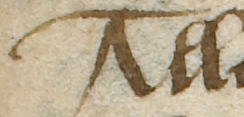 | Usage: Allas
another different form of upper case 'A'. |
|
| D |
 | Usage: doo
the scribe's 'd' is unlooped and varies little from this shape. |  | Usage: shulde
the scribe uses looped 'd' only occasionally as here. |
 | Usage: handes
occasionally 'd' has a fine stroke added at right angles to the ascender. | 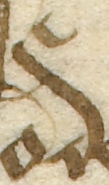 | Usage: lode
'd' on the top line allowing the scribe the licence to extend and decorate. |
|
| G |
 | Usage: longyng
tailed 'g' used throughout. There are usually two horned extensions above the body of the graph. |  | Usage: slomeringes
the second stroke of the graph is very short and thick often with barely an extension for the tail. |
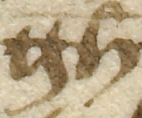 | Usage: mightly | 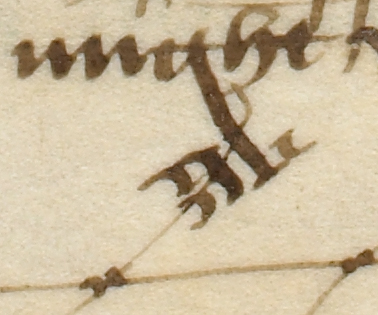 | Usage: might
'g' on bottom line of text with elaborate strapwork decoration into the bottom margin. |
|
| H |
 | Usage: Who
thick, tapering stem with looped head-stroke ending on the shoulder. |  | Usage: How
upper case 'H' at the beginning of a line with pronounced foot at the base of the stem. |
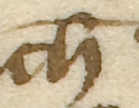 | Usage: Such
'ch' combination with crossed 'h'. | | |
|
| R |
 | Usage: riȝt
this 'r' is used in all positions except after 'o'. |  | Usage: for
'z'-shaped 'r' used only after 'o'. |
 | Usage: horrible |  | Usage: your
'r' in final position with elaborate flourish probably representing a missing 'e'. |
|
| S |
 | Usage: absens
's' in final position frequently has a horn at the top right side of the letter. Only used in final position. |  | Usage: as
the letter is frequently formed like a '6' and has no stroke to join the curve to the horn at the top of the letter. |
 | Usage: Shal be
upper case 'S' to begin a line. The letter has the horn shape both before and after the letter providing symmetry. |  | Usage: sitte
long 's' used initially and in medial positions. |
|
| W |
 | Usage: wight
'w' almost always has a small protuberance for a foot stroke on the lower end of the left limb. |  | Usage: Who
upper case letter at the beginning of a line. |
 | Usage: now
occasionally a joining stroke may be seen between the first and second strokes. | | |
|
| Y |
 | Usage: you |  | Usage: body |
 | Usage: eu(er)y
on the bottom line the scribe is more exhuberant with the length of the tail. | | |
|
| Ampersand |
 | Usage: Ampersand with extra arching stroke above. |  | Usage: Ampersand with no extra superior stroke. |
 | Usage: Ampersand with horned head. | | |
|
| I |
 | Usage: For wel I wote
a thick shadow stroke mimics almost the entire length of the graph. |  | Usage: Now shulde I |
 | Usage: In
this word is at the beginning of a line. This 'I' is without the parallel stroke and is in the scribe's repertoire but he uses the 'I' as in versions 1 and 2 more frequently. | | |
|
| Thorn and Yogh |
 | Usage: þer
even this thorn has a small hook on the lobe. |  | Usage: þe
a thorn of more usual shape. |
 | Usage: riȝt
yogh used for 'gh'. |  | Usage: riȝt
this time the word is on the top line. The scribe uses yogh three times and each time it is for the word 'riȝt'. |
|
| Horned graphs |
 | Usage: seeth
the scribe frequently uses a curved stroke at the top of letters giving the appearance of a horn. It is most noticeable on 's' as in Letter 6 but it can occur almost anywhere. After 's' the most frequent use is on 'e'. |  | Usage: (con)forte
here the scribe uses the abbreviation for 'con' which usually appears resembling the number 9. This too has an idiosyncratic horned appearance. |
 | Usage: he
another example of horned 'e'. | 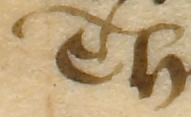 | Usage: That
even the regular upper case 'T' gives the impression of angularity on its stem, despite the smooth curve of the head-stroke. This scribe has so many idiosyncratic features that he should be easily identifiable in other manuscripts. |













































